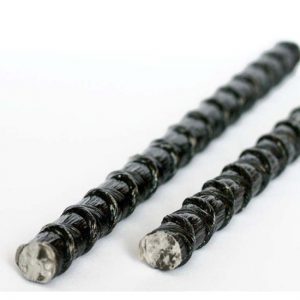
Basalt FRP research ll
- Posted on
- admin
Research:
” A mechanical and environmental assessment and comparison of
basalt fibre reinforced polymer (BFRP) rebar and steel rebar in
concrete beams” by
Marianne Inmana
Eythor Rafn Thorhallssonb
Kamal Azraguea
 The findings have shown that BFRP rebar is a stronger and lighter alternative to steel reinforcement in concrete beams, and that it is a very promising building material for the future. Furthermore, fewer material and energy resources are required during the production process, which leads to a better environmental profile with fewer embodied emissions. In contrast, the mechanical testing part of this experiment showed that the BFRP reinforcement has a lower elastic module than steel reinforcement. This disadvantage leads to excessive deformation at service limit state compared to steel bars, if the same cross-section area is used. However, compared to steel, BFRP does not exhibit yielding during tension. When the BFRP environmental results were compared to EPD data, there were two core findings. Firstly, EPDs for precast steel reinforced concrete beams have a similar amount of GWP emissions, ranging from 25.1 – 27.9 kgCO2eq/FU, compared to the steel reinforced concrete beams tested in this study, 23.7 kgCO2eq/FU. Secondly, when the EPD data for precast beams was replaced with EPD data for in-situ pouring concrete and 100% recycled steel, embodied emissions were significantly reduced to 11.3 kgCO2eq/FU. This result is competitive with the BFRP reinforced concrete beam that experiences 14.6 kgCO2eq/FU. These results highlight the environmental benefits to be
The findings have shown that BFRP rebar is a stronger and lighter alternative to steel reinforcement in concrete beams, and that it is a very promising building material for the future. Furthermore, fewer material and energy resources are required during the production process, which leads to a better environmental profile with fewer embodied emissions. In contrast, the mechanical testing part of this experiment showed that the BFRP reinforcement has a lower elastic module than steel reinforcement. This disadvantage leads to excessive deformation at service limit state compared to steel bars, if the same cross-section area is used. However, compared to steel, BFRP does not exhibit yielding during tension. When the BFRP environmental results were compared to EPD data, there were two core findings. Firstly, EPDs for precast steel reinforced concrete beams have a similar amount of GWP emissions, ranging from 25.1 – 27.9 kgCO2eq/FU, compared to the steel reinforced concrete beams tested in this study, 23.7 kgCO2eq/FU. Secondly, when the EPD data for precast beams was replaced with EPD data for in-situ pouring concrete and 100% recycled steel, embodied emissions were significantly reduced to 11.3 kgCO2eq/FU. This result is competitive with the BFRP reinforced concrete beam that experiences 14.6 kgCO2eq/FU. These results highlight the environmental benefits to be
gained from precast BFRP reinforced concrete beams. It is likely that the future market for basalt rebar will be within the precast industry rather than in on-site construction. This is because the handling of thinner and lighter precast basalt reinforced concrete members will be quicker and easier to install on-site than steel. This is advantageous from an environmental perspective, since precast BFRP concrete beams experience approximately half the emissions of precast steel reinforced concrete beams.
 Another core finding was that both the BFRP tendons and reinforcement steel have similar emission factors: 2.6 and 2.34 kgCO2eq/kg respectively. However, since BFRP has a lower specific weight to steel, and is three times lighter, the overall embodied emissions are much lower in the BFRP reinforced concrete beams. This is because less material (per kg) is required to perform the same function. When considered without concrete, the LCA results showed the largest contributor to BFRP emissions was resin (86.8%). It was therefore ascertained that the LCA results are sensitive to the type and quantity of resin used, and that the amount of embodied emissions arising from resin are a significant driver of high emissions in BFRP tendons. This finding highlights an area for optimisation in the future. BFRP manufacturers could therefore experiment with the
Another core finding was that both the BFRP tendons and reinforcement steel have similar emission factors: 2.6 and 2.34 kgCO2eq/kg respectively. However, since BFRP has a lower specific weight to steel, and is three times lighter, the overall embodied emissions are much lower in the BFRP reinforced concrete beams. This is because less material (per kg) is required to perform the same function. When considered without concrete, the LCA results showed the largest contributor to BFRP emissions was resin (86.8%). It was therefore ascertained that the LCA results are sensitive to the type and quantity of resin used, and that the amount of embodied emissions arising from resin are a significant driver of high emissions in BFRP tendons. This finding highlights an area for optimisation in the future. BFRP manufacturers could therefore experiment with the
composition and quantity of resin required during the BFRP production process with a view to reduce embodied emissions. The development of new environmentally friendly resins could then be applied to all FRP composite materials.
In this study, the same quantity of concrete was used for both steel and BFRP reinforced concrete beam scenarios. It is thought that thinner concrete members could be implemented in the BFRP scenarios, since the mechanical results show that BFRP is much stronger than conventional steel reinforcement. This study highlights that BFRP is an advantageous construction material, and more specifically beneficial as a reinforcement material in concrete beams.
The study highlights that BFRP may also be suitable in other construction applications, such as prefabricated sandwich panels, that require thin concrete facades and thin structural cores. It is expected that using BFRP in thinner concrete sections will have similar, low environmental emissions compared to conventional steel reinforced concrete elements.
It is recommended that further work involves the investigation of thinner concrete members in BFRP reinforced elements, to find out which thickness is required for given performances. This body of work could help the future development of design guidelines and codes for BFRP in construction.
